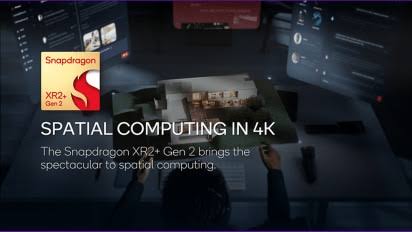Qualcomm Technologies has unveiled a new chipset called XR that will oppose Apple’s Vision Pro headset made up with the Snapdragon XR2+ Gen 2 Platform, a single-chip architecture that enables 4.3K spatial computing at 90 frames per second. This could be a good opportunity for Qualcomm to compete with Apple’s upcoming $3,499 Vision Pro headset. The platform, built on the Snapdragon XR2 Gen 2, supports 12 or more concurrent cameras with on-device artificial intelligence, enhancing XR productivity and entertainment.
Table of Contents
All about Snapdragon XR2+ Gen 2
| Feature | Upgrade over XR2 Gen 2 | Impact on XR Experience |
| Resolution | 4.3K per eye (vs. 3K) | Sharper visuals, deeper textures, life-size overlays |
| CPU/GPU Speed | 20% faster CPU, 15% faster GPU | Smoother animations, reduced jitter, improved responsiveness |
| Concurrent Cameras | 12+ (vs. 10) | More precise hand/eye tracking, accurate full-color passthrough (reduced latency) |
| AI capabilities | Enhanced on-device AI | Natural hand interactions, realistic avatar expressions, advanced spatial mapping |
| Display Technologies | Dynamic Foveated Rendering, Space Warp, Game Super Resolution | Efficient resource allocation, sharper focus, higher perceived framerates |
| Connectivity | Wi-Fi 7 support | Blazing-fast wireless data transfer, low latency for multiplayer XR |
| Power Efficiency | 50% lower power consumption | Lighter, more comfortable headsets, longer battery life |
Qualcomm, on Thursday, introduced the Snapdragon XR2+ Gen 2 Platform, a single-chip engineering designed to empower 4.3K spatial computing at an impressive 90 frames each second. Building on the foundation of the Snapdragon XR2 Gen 2, which powers the Meta Quest 3, the ‘plus’ version boasts a 15% increase in GPU frequency and a 20% boost in CPU frequency, promising a significant jump in immersive experiences.
Samsung and Google as Early Adopters
Samsung and Google have positioned themselves as early adopters of this cutting-edge technology. Inkang Song, VP and Head of Technology Strategy Group at Samsung Electronics, expressed their obligation to create the best-in-class XR experience for World users. The Snapdragon XR2+ Gen 2 enhances visuals as well as supports at least 12 concurrent cameras with on-device simulated intelligence, ensuring seamless user tracking for a really unmatched mixed reality experience.
The Platform’s Potential Impact
Hugo Swart, VP and General Administrator of XR at Qualcomm Technologies Inc, featured the potential impact of the Snapdragon XR2+ Gen 2. With its 4.3K resolution capabilities, the platform aims to hoist XR productivity and entertainment by delivering clear visuals for room-scale screens, life-size overlays, and virtual desktops. This headway underscores Qualcomm’s obligation to powering the best XR devices for an immersive future.
Collaborative Future in XR
Shahram Izadi, VP of AR at Google, expressed fervour about continuing collaboration with Qualcomm Technologies and Samsung in the domain of immersive and spatial XR. Anticipating the Android ecosystem to use the capabilities of Snapdragon XR2+ Gen 2, Izadi sees the potential for enabling novel experiences that redefine the boundaries among physical and advanced spaces.
Roadmap for Mixed Reality Products
While the launch date for headsets from Samsung and Google remains undisclosed, Samsung, during the 2023 World Mobile Congress, uncovered its obligation to develop a roadmap for mixed reality products. This suggests an ongoing effort to bring innovative XR products to advertise, setting the stage for intensified competition in the mixed reality landscape.
In conclusion, the unveiling of the Snapdragon XR2+ Gen 2 Platform marks a significant stride by Qualcomm, Samsung, and Google to challenge Apple’s Vision Pro headset. As these tech giants team up to redefine immersive experiences, the mixed reality landscape is poised for an exciting and cutthroat future.

